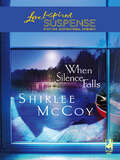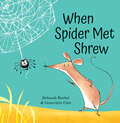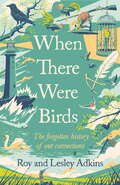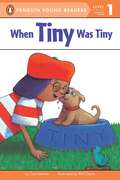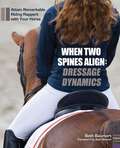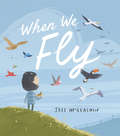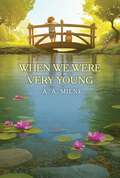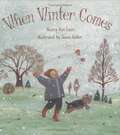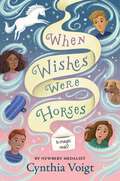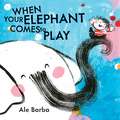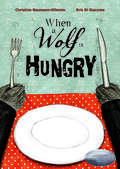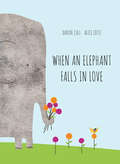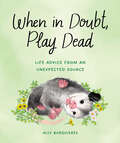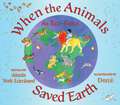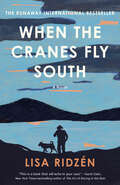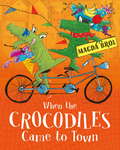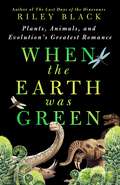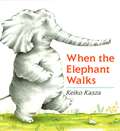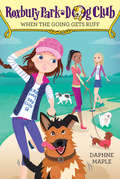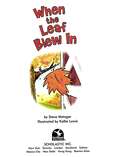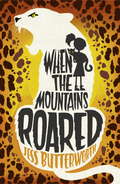- Table View
- List View
When Silence Falls
by Shirlee McCoyAn armed gunman tests a woman’s faith and her relationship with a handsome veteran in this inspirational romantic suspense novel.Life was busy and organized, just the way Lakeview music history professor Piper Sinclair liked it. Some recent family research even meant a new book to write. Until she witnessed an attempted kidnapping—and became a target herself. Someone wanted her out of the way permanently. Someone who seemed to know her all too well . . . His expertise as a former crime scene photographer left Cade Macalister with memories he couldn’t shake. Encountering Piper at the crime scene brought a different set to mind—his friend’s little sister had certainly grown up well, and she couldn’t take on this mysterious assailant alone. Of course, convincing Piper of that would be the only way to solve this dangerous riddle . . . and keep her alive.
When Spider Met Shrew
by Deborah KerbelIn the tradition of fun cumulative stories like The Old Lady Who Swallowed a Fly and If You Give a Mouse a Cookie, this joyful story shows how helping someone in need can sometimes fulfill needs of our own. When Spider meets Shrew, they are both down on their luck. Spider’s web has blown away, and Shrew’s home has just been paved over. What happens when they decide to help each other out? They meet Bat, who is lonely for friends. Then they meet Possum, who can’t find his mom; Dog, who misses her puppies; and Pony, who is out of a job. Everyone has problems, but this quirky new community is ready to lend a hand in creative and surprising ways. This is a joyful story about an unlikely group of friends finding compassion and community in each other. Deborah Kerbel’s humorous, quippy dialogue is perfectly paired with Geneviève Côté’s endearing illustrations of the animal characters. Key Text Features illustrations speech bubbles Correlates to the Common Core State Standards in English Language Arts: CCSS.ELA-LITERACY.RL.K.7 With prompting and support, describe the relationship between illustrations and the story in which they appear (e.g., what moment in a story an illustration depicts). CCSS.ELA-LITERACY.RL.1.3 Describe characters, settings, and major events in a story, using key details. CCSS.ELA-LITERACY.RL.1.4 Identify words and phrases in stories or poems that suggest feelings or appeal to the senses.
When There Were Birds
by Lesley Adkins Roy Adkins'A marvellously original slice of social history' Daily MailBirds are a joy and solace in troubled times, as well as a reminder of past experiences and a symbol of hope for the future. For centuries, they were also seen as a source of food, feathers and even fuel, and being so numerous, many were persecuted as pests. When There Were Birds is a social history of Britain that charts the complex connections between people and birds, set against a background of changes in the landscape and evolving tastes, beliefs and behaviour. Birds were once key elements of the nation's history, traditions and sports, and this gave rise to a rich legacy of literature, language and myths.No other group of animals has had such a complex and lengthy relationship with humankind. Birds have been kept in cages as pets, taught to speak and displayed as trophies. More practically, they have been used to tell the time, predict the weather, foretell marriages, provide unlikely cures for ailments, convey messages and warn of poisonous gases. Although very familiar, birds have often seemed strange, sinister and alarming. With their ability to fly, they bridged the gap between the earth and the heavens, and superstitions were rife because they were presumed to be linked to the supernatural. When There Were Birds draws together many disparate, forgotten strands to present a story that is an intriguing and unexpectedly significant part of our heritage.
When There Were Birds
by Lesley Adkins Roy Adkins'A marvellously original slice of social history' Daily Mail (Book of the Week)'The facts and folklore of birdlife , and man's equivocal relationship with birds, are dissected in admirable detail in this handsome new book' Sunday TimesBirds are a joy and solace in troubled times, as well as a reminder of past experiences and a symbol of hope for the future. For centuries, they were also seen as a source of food, feathers and even fuel, and being so numerous, many were persecuted as pests. When There Were Birds is a social history of Britain that charts the complex connections between people and birds, set against a background of changes in the landscape and evolving tastes, beliefs and behaviour. Birds were once key elements of the nation's history, traditions and sports, and this gave rise to a rich legacy of literature, language and myths.No other group of animals has had such a complex and lengthy relationship with humankind. Birds have been kept in cages as pets, taught to speak and displayed as trophies. More practically, they have been used to tell the time, predict the weather, foretell marriages, provide unlikely cures for ailments, convey messages and warn of poisonous gases. Although very familiar, birds have often seemed strange, sinister and alarming. With their ability to fly, they bridged the gap between the earth and the heavens, and superstitions were rife because they were presumed to be linked to the supernatural. When There Were Birds draws together many disparate, forgotten strands to present a story that is an intriguing and unexpectedly significant part of our heritage.
When Tiny Was Tiny (Tiny)
by Cari MeisterWhen Tiny was a puppy, he fit inside a shoe. He fit in a bag, and he even fit in a pocket. Then Tiny grew, and now he is too big for his doghouse. He is too big to lick his friend's face--yuck! Young readers will enjoy this sweet, funny story about a very big dog who was once a tiny puppy. Not since Clifford has a big dog been so appealing!
When Two Spines Align: Dressage Dynamics
by Beth BaumertWithin riding there exists a fundamental conflict of interest: The rider needs to have control—her confidence depends on her ability to control the balance of her own body as well as that of her very powerful horse. The horse, by nature, needs to feel free—free in both mind and body to express himself through physical movement.In When Two Spines Align: Dressage Dynamics, author Beth Baumert, writer and editor at the internationally recognized equestrian magazineDressage Today, resolves the freedom-control enigma by taking a close look at the individual components that make up riding and dressage. Beth provides insight gleaned from years of working with the best riders, trainers, and judges in the dressage world, and details practical ways riders can learn to harness the balance, energies, and forces at play when they're in the saddle.Readers will discover how to use positive tension and what the author calls the four physical Powerlines—Vertical, Connecting, Spiraling, and Visual—to become balanced and effective in the saddle. Readers will then find ways to understand and manage the horse's balance and coordination challenges, including the fact that he is inherently crooked and naturally inclined to do too much with his front end and not enough with his hind.Ultimately, the rider learns to regulate and monitor the horse's rhythm, energy, flexion, alignment, bend, the height and length of his neck, and, finally, his line of travel by properly aligning her spine with his. When the center of gravity of a balanced rider is directly over the center of gravity of a balanced horse, that place where two spines align becomes the hub for rider and horse harmony—a dynamic and remarkable riding rapport that yields beautiful performance.
When We Fly
by Jess McGeachin*"A gentle, effective presentation of grieving and moving on." --Kirkus Reviews (starred review) A beautiful father-daughter story celebrating love, loss, and healing, and one bird's broken wing that may prove impossible to fix.Lucy has always been good at fixing things--the wonky mailbox, broken watches, even Dad's old binoculars. And Lucy is happy to help her dad; they share a special bond. It's just the two of them, after all. So when Lucy finds a tiny bird with a broken wing, she's sure she can fix him too--but not everything that's broken can be fixed. A tender and loving story about loss, healing, and the special connection between fathers and daughters. Praise for When We Fly: "The core of author-illustrator McGeachin&’s poignant, fantastical tale is grounded in sobering reality, as Lucy&’s father helps her come to terms with the knowledge that not everything is fixable, but he also teaches her that moving forward is possible with the support of loved ones."--Publishers Weekly
When We Were Very Young (The Winnie-the-Pooh Collection)
by A. A. MilneWith a gorgeously redesigned cover and the original black and white interior illustrations by Ernest Shepard, this beautiful edition of the beloved classic poetry collection When We Were Very Young by A. A. Milne is sure to delight new and old fans alike!Before there was Winnie-the-Pooh, there was Mr. Edward Bear, a rotund teddy bear who was proud of his stature. Meet him and many other lovable characters in this verse collection that launched A. A. Milne&’s career as a children&’s author and led to the creation of his novels about Winnie-the-Pooh and Christopher Robin. Full of whimsy, humor, and imagination, these children&’s poems tell of visits to the zoo and Buckingham Palace, the romance between Little Bo Peep and Little Boy Blue, the shenanigans of peculiar characters, quiet afternoons in nature, and more.
When Winter Comes
by Nancy Van LaanRhyming text asks what happens to different animals and plants "when winter comes and the cold winds blow."
When Wishes Were Horses
by Cynthia VoigtWhat would you wish for? In this young middle-grade novel by the Newbery Medal– and Newbery Honor–winning author, four kids in the same town are each granted two wishes. Full of magic, adventure, friendship, family, surprises, and lots of dogs, this is for readers who love Katherine Applegate and Sara Pennypacker.How do such things happen? Something appears, sudden as disaster. It wasn’t there and now it is. An envelope arrives, in your mailbox, on your dinner table, your dresser, your computer keyboard. It’s in your hand. You are alone when it finds you. No one else sees it, to ask about it or take it from you. There is only your name on the envelope. Inside, two pieces of pale gray tissue paper, each the size of a playing card, and simple instructions: ONE WISH AT A TIME WHISPER IT TO ME BE WISEMagic? Impossible. But what if . . . ?Casey, Zoe, Billy, and Bug live in the same town. They don’t know one another . . . yet. But mysteriously, they are connected by magic. Specifically, they’ve each been given two wishes. What would you wish for? Casey yearns for a dog. Zoe wants her parents to stop fighting. Billy has always wanted a unicorn. Bug would love a Lego kit, a really complicated one. And do their wishes come true? The answer may surprise you.
When Your Elephant Comes to Play
by Ale BarbaA hilarious celebration of imagination--and pets--that will have kids laughingWhat&’s a boy to do when an elephant shows up at his door and wants to play? Eating cake makes a big mess, there&’s not enough room in the pool for the two of them, and jumping on the bed may be the biggest disaster of all! But hugs? Well, those work. Elephants are probably the best huggers around. With dozens of laughs, a big elephant sneeze, and a hug you won&’t soon forget, this book will make you wish an elephant came to play at your house too.Praise for When Your Elephant Comes to Play:"An excellent addition to any collection, this appealing tale is full of humor and easily extends imaginative play."--Kirkus "A story as irrepressible as the cross-species pals it stars."--Publishers Weekly"A pleasant read about a little boy&’s big imagination, with creative, colorful spreads that will stay with readers long after the story ends."--Booklist
When a Pet Dies
by Fred Rogers Jim JudkisExplores the feelings of frustration, sadness, and loneliness that a youngster may feel when a pet dies.
When a Wolf Is Hungry
by Christine Naumann-VilleminALA Youth Media Awards: 2018 Batchelder Honor Award WinnerA darkly humorous tale with a twist ending Edmond Bigsnout, lone wolf that he is, loves his solitary cabin in the woods. But lately he's been craving urban rabbit for dinner, so he travels into the city to catch one. Unfortunately, the rabbit has a lot of neighbors—who mistake Edmond for a kind and helpful resident! Perhaps Edmond can become a good neighbor, despite his bad intentions. Readers of all ages will devour this story about a wolf who decides that if you can't eat them, join them.Kirkus Best Picture Books of 2017 Cooperative Children's Book Center&’s "CCBC Choices 2018&”
When an Elephant Falls in Love
by Davide Cali Alice LottiFrom the bestselling author of I Didn't Do My Homework Because... comes an irresistible meditation on the quest for connection. When an elephant falls in love, he does many foolish things. He hides when the elephant-object of his affection is around. He writes dozens of letters that he will never send. And he tries to be healthy, but ends up finishing the cheesecake. This soulful book is at once relatable and revealing, a reminder that love is worth striving for, and that the very best things in life will come to those who wait. Plus, this is the fixed format version, which looks almost identical to the print edition.
When an Elephant Falls in Love
by Davide Cali Alice LottiFrom the bestselling author of I Didn't Do My Homework Because... comes an irresistible meditation on the quest for connection. When an elephant falls in love, he does many foolish things. He hides when the elephant-object of his affection is around. He writes dozens of letters that he will never send. And he tries to be healthy, but ends up finishing the cheesecake. This soulful book is at once relatable and revealing, a reminder that love is worth striving for, and that the very best things in life will come to those who wait.
When in Doubt, Play Dead: Life Advice from an Unexpected Source
by Ally BurguieresFeaturing 70 watercolor illustrations, this totally adorable gift of a book offers wisdom and insight from a delightfully unexpected source: the opossum.Shy, resourceful, and deeply misunderstood yet thoroughly relatable, opossums offer a model for seeing the world—and oneself—in an entirely fresh way. Written and illustrated by Ally Burguieres, creator of the popular Instagram account @ItsMeSesame, who spends her days as a wildlife rehabber caring for and learning from opossums, When in Doubt, Play Dead offers encouragement to embrace life&’s weird, wild, and wonderful moments.Learn to live your life the opossum way with advice including the following. The difference between a weed and a flower is often a matter of taste.It&’s nobody&’s business what&’s in your pouch. Unless you&’ve got snacks in there. In which case, you should share.A bit of risk is part of life. Cross that street, but ALWAYS look both ways beforehand.Smile! Unless someone tells you to, in which case you are well within your rights to scream.And more.With kindness and humor, this enchanting book of life advice will surprise, inspire, and charm you.
When the Animals Saved Earth: An Eco-Fable
by Demi Alexis York LumbardOn a secluded island, in a faraway sea, the animals live in peace and prosperity. But one day, the winds of fate bring humans to their shore. Down come trees and up go houses, farms, and a bustling market. The humans capture the animals and put them to work. A great sadness falls upon the land, and only a young boy named Adam can hear the animals&’ cries. Compelled to act, Adam escapes into the jungle and joins with the remaining free animals, attempting to summon the Spirit King Bersaf. Will the king bring the humans to trial for their harmful actions? Will justice be had? Will balance return to land, sea, and sky? This multicultural environmental tale is inspired by a 1,000 year old animal fable from 10th century Muslim Iraq, which was originally translated by a Jewish rabbi at the command of a Christian king in the 14th century.
When the Cranes Fly South: A Novel
by Lisa RidzénINTERNATIONAL BESTSELLER • WINNER OF THE SWEDISH BOOK OF THE YEAR AWARD • A profoundly moving debut novel that follows an elderly man&’s attempts to mend his relationship with his son before it&’s too late: an emotional story of love, friendship, fatherhood, dogs, and atonement that is already an international sensation. "One of those &‘you&’ll laugh, you&’ll cry, you&’ll want to buy twenty copies and give them to everyone you love&’ books.&” —Fredrik Backman, bestselling author of A Man Called Ove, in The New Yorker &“A powerful, sneakily emotional meditation on life and death, and the foundational relationships in our lives. This is a book that will echo in your soul.&” —Garth Stein, New York Times bestselling author of The Art of Racing in the RainBo is running out of time. Yet time is one of the few things he&’s got left. These days, his quiet existence is broken up only by daily visits from his home care team. Fortunately, he still has his beloved elkhound Sixten to keep him company … though now his son, with whom Bo has had a rocky relationship, insists upon taking the dog away, claiming that Bo has grown too old to properly care for him. The threat of losing Sixten stirs up a whirlwind of emotion, leading Bo to take stock of his life, his relationships, and the imperfect way he&’s expressed his love over the years.
When the Crocodiles Came to Town
by Magda BrolAn exhilaratingly fresh, funny picture book with a strong message about rejecting prejudice and welcoming new arrivals from brilliantly talented debut author-illustrator Magda Brol.No one knows why the crocodiles have come to Dullsville. They look different. They act differently. And worst of all? They love messy, sticky, colourful ice cream. Yuck!But one little boy knows differently, and when two naughty thieves arrive in Dullsville one night, the whole town sees how much Dullsville needs its two brave and loyal crocs . . . A strong message about embracing difference and rejecting prejudice, delivered with bags of charm and toothy crocodile humour.
When the Earth Was Green: Plants, Animals, and Evolution's Greatest Romance
by Riley BlackWinner, A Friend of Darwin Award, 2024 A gorgeously composed look at the longstanding relationship between prehistoric plants and life on EarthFossils plants allow us to touch the lost worlds from billions of years of evolutionary backstory. Each petrified leaf and root show us that dinosaurs, saber-toothed cats, and even humans would not exist without the evolutionary efforts of their leafy counterparts. It has been the constant growth of plants that have allowed so many of our favorite, fascinating prehistoric creatures to evolve, oxygenating the atmosphere, coaxing animals onto land, and forming the forests that shaped our ancestors’ anatomy. It is impossible to understand our history without them. Or, our future.Using the same scientifically-informed narrative technique that readers loved in the award-winning The Last Days of the Dinosaurs, in When the Earth Was Green, Riley Black brings readers back in time to prehistoric seas, swamps, forests, and savannas where critical moments in plant evolution unfolded. Each chapter stars plants and animals alike, underscoring how the interactions between species have helped shape the world we call home. As the chapters move upwards in time, Black guides readers along the burgeoning trunk of the Tree of Life, stopping to appreciate branches of an evolutionary story that links the world we know with one we can only just perceive now through the silent stone, from ancient roots to the present.
When the Elephant Walks
by Keiko KaszaA charming circular story where the tiniest animal just might be the most powerful.When the Elephant walks, he scares the Bear. When the Bear runs away, he scares the Crocodile. When the Crocodile swims for his life, he scares the Wild Hog . . . and so on, down to the Mouse. And who could be scared of the little Mouse? The last spread answers this question in a way that will delight small children-and the endearing animals, rhythmic text, and hilarious illustrations will make this book a favorite.
When the Going Gets Ruff (Roxbury Park Dog Club #2)
by Daphne Maple Annabelle MetayerWhat's better than being best friends? Being best friends who volunteer together at the Roxbury Park Dog Shelter! With a focus on friendship, family, and cute canines, Roxbury Park Dog Club is perfect for tween readers who snap up books from series like Cupcake Diaries and Candy Apple, or for anyone who loves dogs.This second book focuses on Sasha, who has always wanted a pet. There's only one problem: her mom doesn't think she's responsible enough. Sasha knows she can be forgetful sometimes, but after weeks of volunteering at the Roxbury Park Dog Shelter with her friends Kim and Taylor, she's sure she can convince her mom she's ready to take care of a pet. But then the newest dog in the girls' after-school dog care program turns out to be too rambunctious to manage. How can Sasha prove she's responsible if she can't get one problem puppy under control?
When the Invasion of Land Failed: The Legacy of the Devonian Extinctions (The Critical Moments and Perspectives in Earth History and Paleobiology)
by George McGhee Jr.The invasion of land by ocean-dwelling plants and animals was one of the most revolutionary events in the evolution of life on Earth, yet the animal invasion almost failed—twice—because of the twin mass extinctions of the Late Devonian Epoch. Some 359 to 375 million years ago, these catastrophic events dealt our ancestors a blow that almost drove them back into the sea. If those extinctions had been just a bit more severe, spiders and insects—instead of vertebrates—might have become the ecologically dominant forms of animal life on land. This book examines the profound evolutionary consequences of the Late Devonian extinctions and the various theories proposed to explain their occurrence. Only one group of four-limbed vertebrates exists on Earth, while other tetrapod-like fishes are extinct. This gap is why the idea of "fish with feet" seems so peculiar to us, yet such animals were once a vital part of our world, and if the Devonian extinctions had not happened, members of these species, like the famous Acanthostega and Ichthyostega, might have continued to live in our rivers and lakes. Synthesizing decades of research and including a wealth of new discoveries, this accessible, comprehensive text explores the causes of the Devonian extinctions, the reasons vertebrates were so severely affected, and the potential evolution of the modern world if the extinctions had never taken place.
When the Leaf Blew In
by Steve MetzgerA wonderfully zany story about what happens on a farm when a leaf blows into the barn! When the leaf blows into the barn, The cow sneezes "Ah choo!" And when the cow sneezes "Ah choo!" The spider falls on top of the owl. With simple, repetitive text and silly, expressive illustrations, children will fall for this hilarious autumn story about the way one leaf turns an entire barnyard upside down!
When the Mountains Roared
by Jess ButterworthA vivid, warm and atmospheric adventure set in the mountains of India, about a girl who is determined to protect the wild leopards of the mountain from poachers, perfect for fans of Katherine Rundell.I thought we'd live here forever ... but then, I thought Mum would be here forever too.When Ruby's dad uproots her from Australia to set up a hotel in the mountains of India, Ruby is devastated. Not only are they living in a run-down building in the middle of the wilderness surrounded by scorpions, bears and leopards, but Ruby is sure that India will never truly feel like home - not without her mum there.Ever since her mum died, Ruby has been afraid. Of cars. Of the dark. Of going to sleep and never waking up. But then the last remaining leopards of the mountain are threatened and everything changes. Ruby vows to do all she can to protect them - if she can only overcome her fears...
